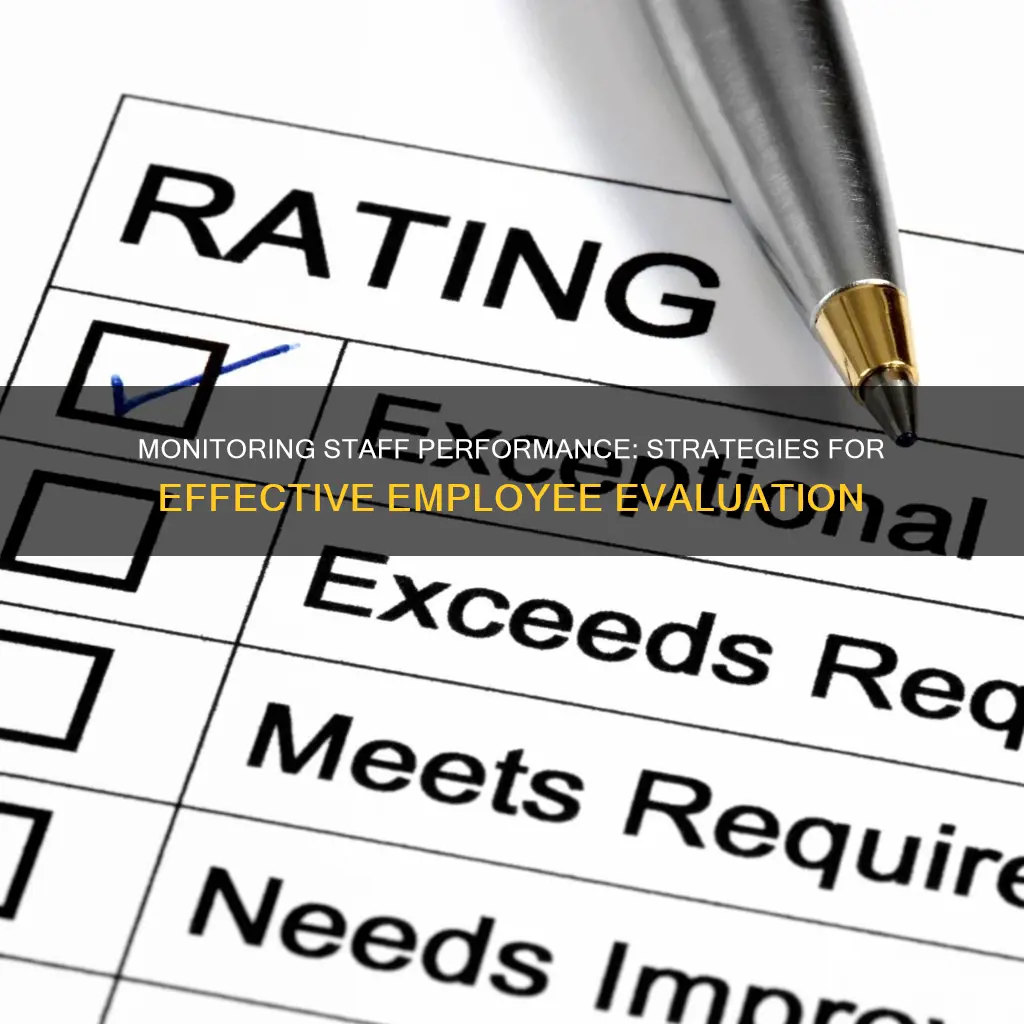
Monitoring employee performance is a key aspect of a manager's role. It can help to increase productivity and employee satisfaction, and ensure that employees are completing their tasks effectively and to a high standard. However, it is a delicate balance, as managers don't want to be seen as micromanaging or spying on their employees. So, what are the best ways to monitor staff performance without infringing on privacy?
| Characteristics | Values |
|---|---|
| Website activity | Which websites are visited and for how long |
| Task completion time | Tracked through tools or screenshots |
| Mouse movements | How active employees are |
| Percentage of tasks completed | |
| Work phone calls or meetings | Recorded or listened to |
| Software | Monitoring software, task management software, time tracking software |
| Self-monitoring tools | Checklists, activity logs, schedules |
| Regular check-ins | Spontaneous and unscheduled |
| KPIs | Effectiveness ratio/employee efficiency |
| 360-degree feedback | Feedback from colleagues and other managers |
| Reward and recognition | |
| Planning sessions | To communicate expectations |
| Selective control | Monitoring a few employees at a time |
| Employee surveys and feedback | Gauging employee engagement |
What You'll Learn

Utilise monitoring software
Using monitoring software is an effective way to track staff performance and ensure employees are completing their tasks effectively and to a high standard. It is a more productive approach than waiting for an annual review or jotting down endless notes. Monitoring software can help managers identify who needs support and detect backlogs to improve productivity.
There are many types of monitoring software available, with features such as:
- Time tracking
- Screenshots
- Keystroke logging
- Website and application usage tracking
- File transfer and document tracking
- Screen recording
- Location tracking
- Geofencing
- Attendance and leave management
- User behaviour analytics
When selecting monitoring software, it is important to consider your business goals and specific objectives. If you are aiming to boost productivity, features such as time tracking, activity logs, and website and application usage tracking might be key. If data security is a priority, alerts for unusual activity or access to sensitive information will be critical. For remote teams, location tracking and screen recording may be useful, while office-based teams might require less stringent monitoring.
It is also essential to respect employee privacy and strike a balance between gathering useful data and maintaining trust. Overly invasive software can harm morale and negatively impact productivity. Therefore, when choosing monitoring software, it is crucial to select a user-friendly platform that is straightforward for both administrators and employees to navigate.
Additionally, ensure you comply with relevant data protection laws and regulations, such as The Data Protection Act 2018 in the UK. Before implementing any monitoring software, be transparent with your employees about what will be monitored and how often. Open communication and consent are essential to maintaining trust and avoiding potential legal issues.
Hooking Up Your GameCube to a Monitor: A Guide
You may want to see also

Regular check-ins
Establish a Routine
The first step to effectively monitoring employee performance is to establish a routine of regular, ongoing, one-on-one meetings. This will help managers stay on top of the details and hold people accountable. These meetings can be in-person or virtual, depending on the work environment and the employee's preferences.
Set Clear Goals and Expectations
Before the check-in meetings, it is important to set clear goals and expectations for the employees. This could include outlining milestones, deadlines, and any other specific tasks or targets that need to be achieved. This will provide a structure for the check-in meetings and allow for a more accurate evaluation of the employee's performance.
Ask for an Account of their Work
During the check-in meetings, ask the employees for an account of their work since the last meeting. This could include questions such as "What concrete actions did you take?" or "Did you meet the clearly spelled-out expectations?". By listening carefully and asking probing questions, managers can hold employees accountable for their actions and provide guidance where needed.
Focus on Employee Well-being
Provide Support and Guidance
If an employee is facing challenges or issues, managers can use the check-in meetings to provide support and guidance. This could include helping them set realistic goals, providing additional resources, or offering feedback and suggestions for improvement. It is important for employees to feel that they are supported and that their concerns are being addressed.
Be Mindful of Mental Health
Checking in with employees can also be a way to assess their mental health and well-being. Managers can use these opportunities to show that they care and are there to provide support if needed. This can help create a positive work environment and improve employee motivation and satisfaction.
In conclusion, regular check-ins are an essential part of monitoring employee performance. By establishing a routine, setting clear goals, asking for an account of their work, focusing on well-being, providing support, and being mindful of mental health, managers can effectively evaluate and improve employee performance while also fostering a positive and supportive work environment.
Amazon Monitor Buying Guide: Is it Reliable?
You may want to see also

Self-monitoring tools
Time-management tools such as Asana and Trello can help employees track their tasks and deadlines and improve cross-departmental collaboration. Such tools can also help staff pick up new skills, such as time management, problem-solving, and accountability.
Other self-monitoring tools include project plans and activity logs, which allow employees to monitor whether they are meeting goals and deadlines. Activity logs are diaries that employees keep throughout the day, noting their activities, breaks, and interruptions. Each time an employee moves on to a new activity, they note the time and the nature of the activity.
Kindle Fire to Monitor: Easy Steps for Connection
You may want to see also

Performance reviews
Benefits of Performance Reviews
Challenges with Traditional Annual Reviews
Traditional annual performance reviews often fail to accurately capture employees' performance due to recency bias, which can result in an unfair evaluation and hinder employees' professional growth. The rigid structure of annual reviews may not align with the agile and dynamic nature of today's workforce, which requires frequent performance management and real-time feedback. Employees may also feel anxious or demoralised leading up to their annual performance review, fearing criticism or potential negative consequences.
Best Practices for Performance Reviews
- Frequency: Performance reviews should happen more frequently than annually, with quarterly or monthly conversations recommended. This allows managers and employees to stay aligned and adapt to unexpected changes.
- Two-way conversation: Performance conversations should be engaging, with both parties contributing equally.
- Future-focused: While it is important to reflect on the past, performance reviews should primarily focus on the future and how employees can improve going forward.
- Transparency: Employees should be involved in the process early on to reduce anxiety, and both parties should know exactly what to expect.
- Objectivity: Performance reviews should be based on data and specific examples rather than the manager's personal opinion.
- Technology-enabled: Using performance review software can simplify the process and enhance effectiveness.
- Action plan: Performance conversations should conclude with agreed-upon next steps and a clear action plan.
Tips for Conducting Performance Reviews
- Reflect on the past and focus on the future: While it is important to acknowledge past performance, the main focus should be on future success and how employees can improve in real-time.
- Ask the right questions: Inviting honest and genuine feedback and uncovering ways to improve performance.
- Choose your phrases carefully: Use specific, measurement-oriented, and powerful language that is positive and constructive.
- Be an active listener: Facilitate a two-way dialogue and dig deeper with follow-up questions to paint a fuller picture.
- Wrap up with next steps: Agree on a new or revised set of goals and discuss training, development, incentives, or other measures to support employees in achieving their goals.
Performance Review Templates
Using performance review templates can enhance the feedback process and turn it into a strategic initiative. Templates help streamline the process and ensure consistency, while also allowing for customisation to specific teams and roles, reflecting the organisation's culture and values.
Are My Text Messages Being Monitored? Signs to Look For
You may want to see also

Task management software
When choosing a task management software, it is important to select one that provides the required monitoring insights while maintaining employee privacy. The software should offer features such as automatic time tracking, task management, and progress monitoring, with options for customisation and user grouping.
- Setting Clear Goals and Expectations: Clearly defined goals and expectations are essential for effective performance management. Managers should set relevant, achievable, and time-bound goals for employees, breaking them down into specific tasks to simplify execution and tracking.
- Regular Check-Ins and One-on-One Meetings: Regular check-ins and individual meetings with employees provide a casual format for monitoring performance. These meetings help maintain transparency, foster positive working relationships, and ensure employees and managers are aligned before formal performance reviews.
- Performance Benchmarking: Task management software often includes features for benchmarking employee performance. This allows managers to set performance standards and track whether employees are meeting expectations.
- Progress Tracking and Feedback: Software that tracks work-in-progress allows managers to detect problems early and provide timely feedback. Regularly reviewing employee progress helps identify areas where employees may need additional support or training.
- Self-Monitoring Tools: Providing employees with access to self-monitoring tools can improve engagement and ownership over their tasks. This empowers employees to track their performance independently and identify areas for improvement.
- Productivity Scoring: Some software solutions offer productivity scoring, which shows how each employee is performing and awards points for early task completion. This feature can help managers acknowledge and reward high-performing employees.
- Visual Monitoring: For in-person teams, direct observation can be an effective way to gain insight into employee performance. However, this method may not be feasible for remote teams, making task management software a more suitable option.
When implementing task management software for performance monitoring, it is crucial to consider the potential impact on employee trust and privacy. Open communication and transparency about the monitoring process can help build trust and ensure employees understand the benefits of these tools for their own development and the organisation's success.
GameStop Buys Monitors: What You Need to Know
You may want to see also
Frequently asked questions
Monitoring staff performance can help managers identify skills gaps, improve employee engagement, productivity, motivation and well-being, and provide more appropriate feedback. However, it can also lead to a breakdown in trust, a lack of transparency, and increased stress and lower morale among employees.
There are several methods that can be used to monitor staff performance, including:
- Using monitoring software to track activities and analyse data.
- Regular check-ins and one-on-one meetings to discuss progress and performance.
- Self-monitoring tools such as checklists, activity logs, and time-management tools.
- Project management software to track tasks, progress, and milestones.
- Gathering feedback from colleagues and other managers.
It is important to ensure that any staff monitoring complies with relevant data protection and privacy laws, such as The Data Protection Act 2018 in the UK or GDPR in the EU. Employees should also be made aware of what information is being collected and how it will be used.
To avoid micromanaging, it is important to strike a balance between monitoring and supporting employees. This can be achieved by scheduling regular check-ins, using project management software, and fostering a culture of open communication and trust. It is also crucial to respect employees' privacy and provide clear expectations and goals.







